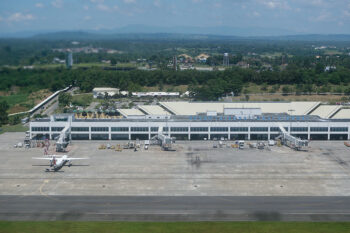WAO, Lanao del Sur (MindaNews / 13 April) — Anyone passing by Serran Elementary School here late Wednesday afternoon could not have missed the sight of a camping tent on the school grounds, a grandmother, a mother and several grandchildren seated on mats and blankets. They were not there for a picnic but to spend the night safely, following the series of aftershocks from the magnitude 6 quake that struck at 5:21 a.m. on April 12, and registered Intensity VII here and in neighboring Kalilangan town in Bukidnon.
The quake left no casualties but struck fear among thousands of residents.
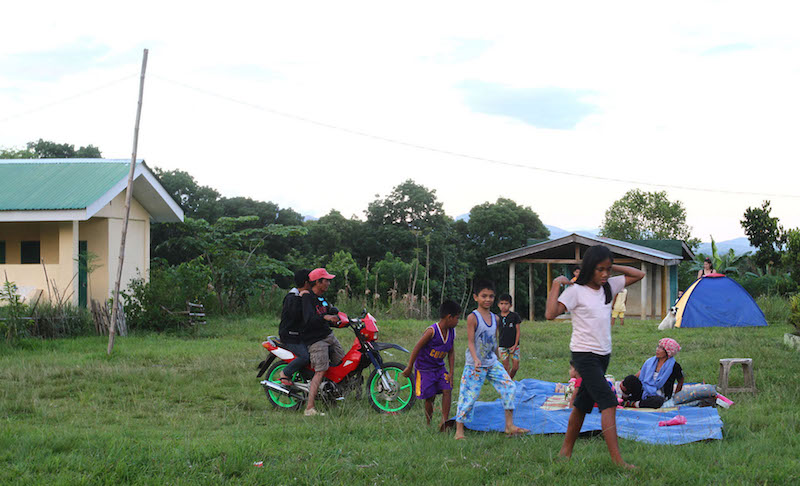 Some residents in Barangay Serran, Wao, Lanao del Sur spend the night at the school ground for safety reasons following the series of aftershocks on Wednesday. Photo taken on April 12. MINDANEWS PHOTO
Some residents in Barangay Serran, Wao, Lanao del Sur spend the night at the school ground for safety reasons following the series of aftershocks on Wednesday. Photo taken on April 12. MINDANEWS PHOTO
Sixty-five year old Annie Sayson told MindaNews late Wednesday afternoon that she, her grandchildren and other relatives, including a three-month old baby boy, feel safer camping out on the grounds of the Serran Elementary School in Barangay Serran, just beside her house, rather than spend the night in their respective houses.
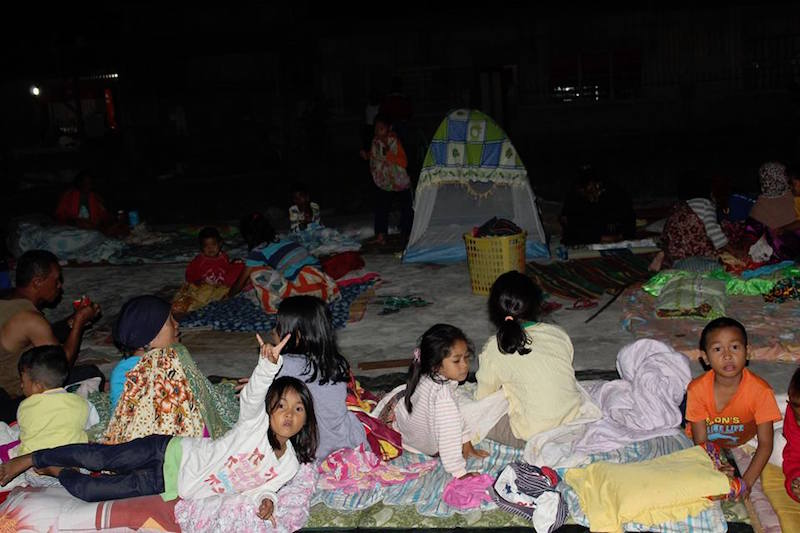 Residents of Barangay Kilikili in Wao, Lanao del Sur spend Wedesday night on the road following the series of aftershocks after the magnitude 6 quake that registered Intensity VII in Wao and neighboring Kalilangan town in Bukidnon. Photo courtesy of GILBERT ERROL PEDROSA
Residents of Barangay Kilikili in Wao, Lanao del Sur spend Wedesday night on the road following the series of aftershocks after the magnitude 6 quake that registered Intensity VII in Wao and neighboring Kalilangan town in Bukidnon. Photo courtesy of GILBERT ERROL PEDROSA
In Barangay Kilikili, also in Wao, Errol Pedrosa posted photographs of residents spending Wednesday night “sleeping at the sidewalks, inside the parked van, tricycle, open plaza, some with mosquito nets, others with tents and malongs and some others with ordinary blankets.”
Pedrosa said they only had one wish that night: “No rain please!”
“What a day and night this one is! Lord have mercy on us…,” Pedrosa wrote.
On Thursday morning, residents were again jolted by a magnitude 5.3 quake at 4:01 a.m., one of many aftershocks that registered Intensity VI in Kalilangan and V in Wao town.
Intensity VII is classified by the Philippine Institute of Volcanology and Seismology (Phivolcs) as “destructive,” VI is “very strong” and V is “strong.”
“No entry zone”
In Kalilangan, Bukidnon, a yellow “caution” barricade tape surrounds the two-floor Sangguniang Bayan (Municipal Council) building here which has been declared a “no entry” zone.
Of the ten government buildings that suffered damages in Kalilangan, the relatively new building of the Sangguiang Bayan (Municipal Council) has been classified as “heavily damaged, no entry zone,” the initial report released by the Municipal Disaster Risk Reduction and Management Office (MDRRMO) said in its situation report as of 2:49 p.m. on April 12, 2017.
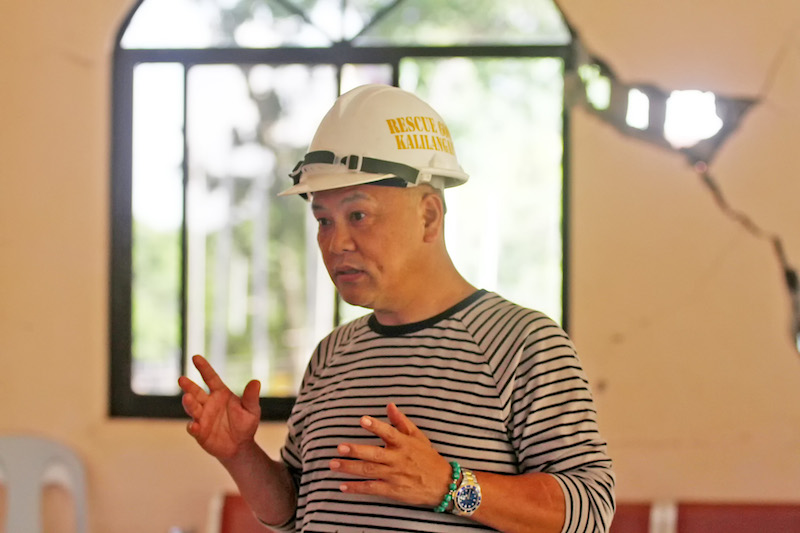 Kalilangan mayor Omaradji Pizarro at the Sangguniang Bayan building that has been declared a “no entry” zone. MINDANEWS PHOTO
Kalilangan mayor Omaradji Pizarro at the Sangguniang Bayan building that has been declared a “no entry” zone. MINDANEWS PHOTO
Mayor Omaradji Pizarro told MindaNews he immediately ordered the suspension of work. A former contractor, the mayor led MindaNews inside the building after the MDRRMO personnel gave out hard hats.
Portions of the ceiling collapsed, cracks were seen on walls in the different offices and the wall of the session hall left a hole. A few meters away, the town hall, suffered only minor cracks.
On Thursday, Pizarro said damages in the SB building “slightly worsened” after the 4:01 a.m. magnitude 5.3 quake.
The MDRRMO’s initial report said the other buildings — the town hall, terminal, the Kalilangan National High School in Barangay Ninoy Aquino and the Macaopao Elementary School in Barangay Macoapao — suffered “minor cracks,” the three barangay halls of Macaopao, Central Poblacion and Ninoy Aquino and the Bukidnon Provincial Hospital in West Poblacion were classified “slightly damaged,” while two spans of the Kalilangan Central Elementary School’s perimeter fence was damaged.
Two bridges in Kalilangan were also affected but are both passable: the Ninoy Aquino bridge connecting Barangay Central with Barangay Ninoy Aquino suffered minor cracks at the bottom girder while hairline cracks were found along the abutment of the Malatipay Bridge in Cogo, Macaopao.
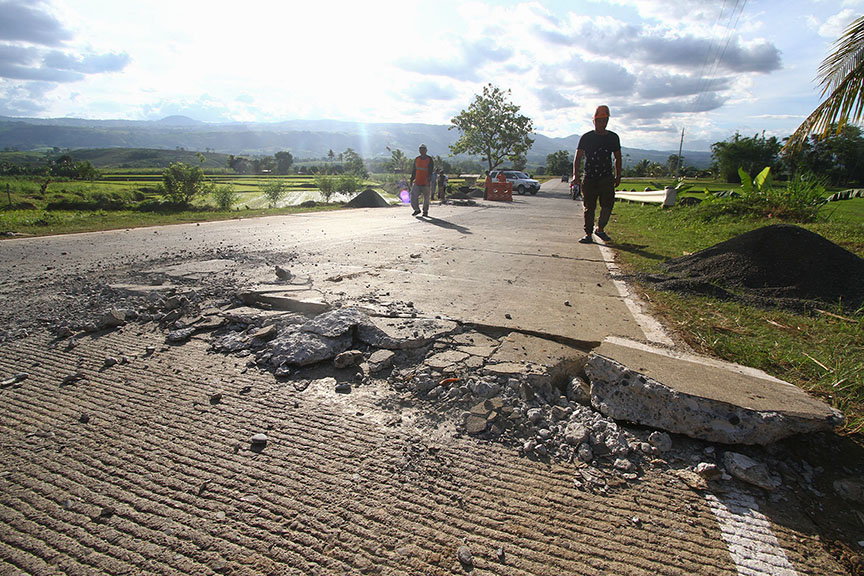 A portion of the national highway in Kalilangan town in Bukidnon was damaged by Magnitude 6 earthqauke on April 12 morning. Mindanews Photo
A portion of the national highway in Kalilangan town in Bukidnon was damaged by Magnitude 6 earthqauke on April 12 morning. Mindanews Photo
Government engineers noted soil failure at the shoulder side of the carriageway at the junction of Maradugao-Camp Kibaritan-Domirog road in Olayan, Malinao, and “damage of Portland Cement concrete pavement both lanes” along Cogo in Barangay Macaopao.
Kung nadugay pa…
The tremor damaged a portion of the highway in Macaopao leading to Pangantukan town when a span of the road got disaligned by 6.5 inches and left a gap between the lanes and the road shoulder.
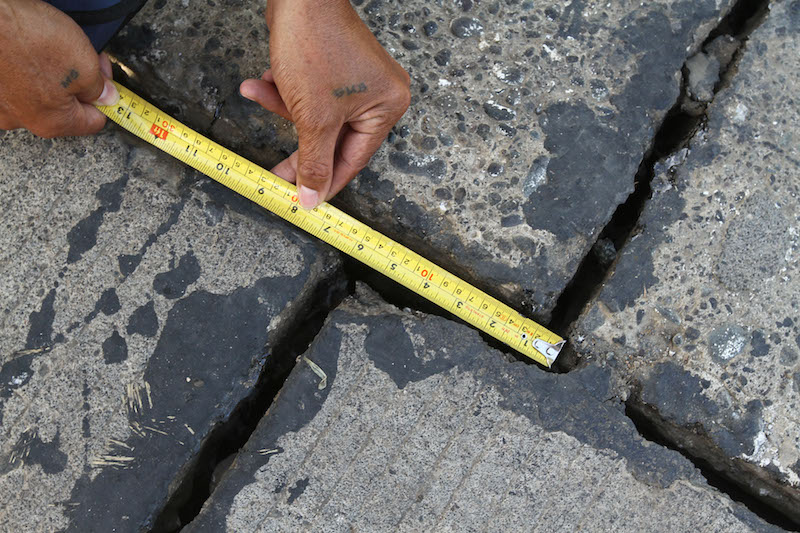 A portion of the highway in Barangay Macaopao got disaligned by 6.5 inches following the magnitude 6 quake early Wednesday morning. Barangay Captain Ermilo Galon they were fortunate the quake lasted only for a few seconds. MINDANEWS PHOTO
A portion of the highway in Barangay Macaopao got disaligned by 6.5 inches following the magnitude 6 quake early Wednesday morning. Barangay Captain Ermilo Galon they were fortunate the quake lasted only for a few seconds. MINDANEWS PHOTO
“Maayo na lang kadali lang ang linog. Sus kung nadugay pa to…” (It was good the quake lasted only for a few seconds. If it had taken longer…” Barangay Captain Ermilo Galon said.
Landslides were recorded in Barangays Ninoy Aquino and Malinao but no casualties were reported.
A few meters away from the damaged portion of the road, Elena De Asis Salvacion, 58, said she was grateful she managed to get out of her house just as the wall of her room, made of hollow blocks with thin round bars, collapsed. The trusses moved about a foot away.
When she stepped out, she was worried sick if her daughter who was in another room and her husband who was also in another room, survived. They did.
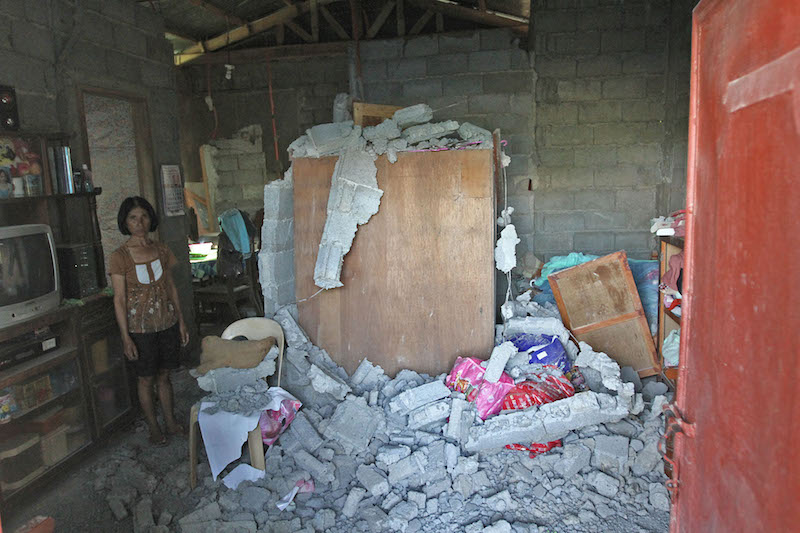 Elena de Asis Salvacion managed to get out of her house in Barnagay Macaopao just before the wall made of hollow blocks collapsed. MINDANEWS PHOTO
Elena de Asis Salvacion managed to get out of her house in Barnagay Macaopao just before the wall made of hollow blocks collapsed. MINDANEWS PHOTO
A white framed clock, its minute and hour hands no longer working, lay near the entrance to her house. “Na-pass out ang wall clock. Nahulog sa divider,” she said, referring to how the wall clock was destroyed after it fell off the divider.
A number of residents in Barangay Kilikili here said their television sets were destroyed by the quake. But most residents here are complaining about the lack of water, particularly drinking water.
“Wala nang mabiling mineral water” (There’s no more mineral water available), said Catherine Pedrosa, Errol’s wife.
Fr. Yrap Nazareno, parish priest of Wao, told MindaNews in a text message Thursday morning that the normal supply of water has yet to be restored. “There is water flowing in our faucets but obviously soiled as they appear brownish,” he said.
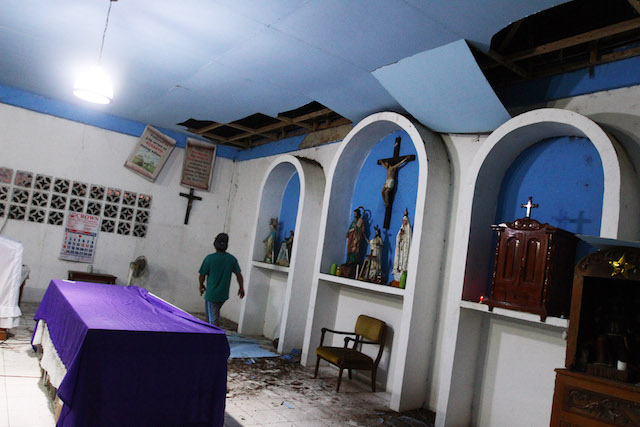 A portion of the ceiling of San Jose chapel in Barangay Kili-kili, Wao, Lanao del Sur collapsed due to the magnitude quake at 5:21 a.m. on Wednesday, 12 April 2017. The statues of St. Joseph and other religious icons were found to have moved to the edge of the retable but not one fell. MINDANEWS PHOTO
A portion of the ceiling of San Jose chapel in Barangay Kili-kili, Wao, Lanao del Sur collapsed due to the magnitude quake at 5:21 a.m. on Wednesday, 12 April 2017. The statues of St. Joseph and other religious icons were found to have moved to the edge of the retable but not one fell. MINDANEWS PHOTO
At the San Jose Chapel in Barangay Kilikili, portions of the ceiling behind the altar collapsed, but the statues of St. Joseph and other religious icons on the retable remained intact. Lay leader Jun Eleazar who rushed early Wednesday morning to check on the chapel told MindaNews he found the statues had moved and stood on the edge, but not one fell.
Movement of fault
A primer on the 12 April Magnitude 6.0 earthquake in Lanao del Sur issued by Phivolcs on April 12 said Wednesday’s quake was “generated by the movement of a northwest trending active fault in the area.”
Based on preliminary intensity reports, the strongest ground shaking was felt at Phivolcs Earthquake Intensity Scale (PEIS) VII (Destructive) in Wao, Lanao del Sur and Kalilangan, Bukidnon, Intensity VI (Very Strong) in Amai Manabilang, Lanao del Sur; V (Strong) in Pangantukan, Bukidnon, and Banisilan, Cotabato.
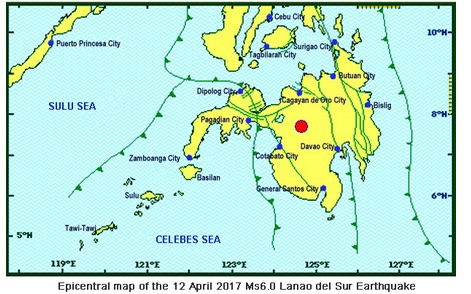 Courtesy of Phivolcs
Courtesy of Phivolcs
The quake was also felt at Intensity IV in Cagayan de Oro City, Iligan City, Cotabato City, Gingoog City in Misamis Oriental, Matalam in North Cotabato, Valencia and Maramag in Bukidnon, and Davao City and Inensity III to I in Kabacan and Arakan in North Cotabato, Quezon and Don Carlos in Bukidnon, Pikit in Cotabato, Lebak in Sultan Kudarat, Kidapawan City, Koronadal City, and Mambajao in Camiguin.
The Phivolcs primer, however, said that Wednesday’s quake in Wao and Kalilangan was not the strongest. It said the area experienced a magnitude 7.5 quake on April 1, 1955.
“This earthquake, which is considered to be one of the most damaging historical earthquakes in Lanao del Sur, resulted to about 400 deaths. Strong ground shaking was also felt during this event, resulting to significant damage to infrastructures including a mosque in Tugaya municipality near Lake Lanao. Several houses also collapsed and wharfs were damaged in Zamboanga City and Pagadian City. Liquefaction and landslides were also documented,” the primer said.
Phivolcs said Central Mindanao, including Lanao del Sur, is one of the seismically active areas in the country because of the presence of the western extension of the Mindanao Fault (Cotabato-Sindangan Fault), an active fault that runs from Sarangani province to northwest of Zamboanga Peninsula. Cotabato Trench is also a major source of earthquakes which can affect the region. In addition, there exist other local active faults, which can be sources of small- to moderate-magnitude earthquakes, it said. (Carolyn O. Arguillas / MindaNews)
